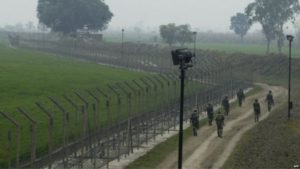
After every terror attack in India in the past few years, there is an escalation in rhetoric for taking punitive action against perpetrators within and outside the country. These developments have escalated military, diplomatic and political tensions between India and Pakistan, which are a grave cause of concern since both are nuclear powers and Pakistan has a ‘first strike’ doctrine. These developments raise an important question; are there any better solutions available to ensure that incidents, of militants infiltrating from Pakistan and carrying out strikes in India, can be minimized, and how the suffering of people living in border areas which are being caused by tension between these two countries can be minimized through better border security and management.
Following the Kargil conflict, a Task Force on Border Management under the Chairmanship of Madhav Godbole (former Home Secretary Government of India) was formed, the report recommended for accelerated development of infrastructure along the border, especially to dissuade the border population from engaging in illegal activities. After this report, the government has made concerted efforts to create comprehensive security infrastructure at the border especially in the western sector.
After militant attacks in Gurdaspur (July 2015) and Pathankot (January 2016), it was revealed during investigations that these attacks were carried out by militants who crossed over from International border on the Punjab side, although this border is fenced, and is effectively guarded by Border Security Force and has fencing on Indian side, to check infiltration. But subsequent investigations revealed some gaps in border guarding, like the riverine gaps which are being caused by seasonal rivers and river ‘Beas’ flowing from Indian side to Pakistan. The Government of India decided to improve its border infrastructure and following Israel model of border protection, launching the Comprehensive Integrated Border Management System (CIBMS). In January 2016, the Centre approved a five-layer elaborate plan to stop infiltration on the 2,900-km western border with Pakistan. Close Circuit Television Cameras, thermal imagers and NVDs, BFSRs, underground monitoring sensors, and laser barriers will be placed along the border to track all movement from the other side. The integrated setup will ensure that in the event of a transgression if one device fails to work, another will alert the control room.
Although this model of CIBMS is still in experimental stage still there is need to include other stakeholders and assess the social impact of the project. Like the land acquisition issue, for the establishment of surveillance infrastructure which will involve local state government of Punjab, for assessment and fair distribution compensation of land acquisition. The main objective of any security infrastructure is to create a sense of security to its citizens for that the government is expected to make a multidisciplinary study like the crime control, socio-economic development of border towns and villages. In this context, the Punjab state government has launched de-addiction programme so that domestic demand for psychotropic substances can be controlled which is directly linked to border crimes. The “Punjab Government is committed to wiping out the menace of drug abuse, and multi-pronged strategy has been adopted to accomplish this task. Already a Special Task Force (Anti-drug) has been constituted, which is stringently enforcing the law and nabbing the violators, and on the other hand the Govt. is providing effective de-addiction and rehabilitation services for people affected to drug abuse”. The subject of the border and national security are its citizens comprehensive economic, social and enforcement infrastructure will be more stable and acceptable to the local population.
Also, there is an immediate need for India to strengthen its border security and adopt foreign models from the United States and Israel in border guarding and management, which are comprehensive models in the context of border security. The structure of the Department of Homeland Security is another comprehensive model that could be used for inspiration, in that multiple agencies responsible for border guarding and management were brought under one single department, with corporate players like ‘Accenture’ contributing to the security of borders as far as electronic surveillance and data handling is concerned.
The structure of the Department of Homeland Security of United States is another comprehensive model that could be used for inspiration, in that multiple agencies responsible for that were brought together under one organization responsible for border security and management. Moving forward, to resolve these disputes and for increased accountability between the two states, India and Pakistan needs to adopt the United States-Mexico model of economic interdependence like an increase in local trade and allowing local work permits. Both the countries must understand the suffering of border population stems from border tensions due to which the population on both the sides faces temporary displacement, loss of livelihood and causalities of humans and livestock. This kind of adverse development affects common citizen by putting restrictions on travel for business, medical treatment, and even religious tourism. India and Pakistan are ethnically and demographically are very closely linked, and denial of people to people contact is not going to produce positive outputs. Time is ripe now for both, India and Pakistan to do some diplomatic and inter-ministerial groundwork on formalizing border agreement and creating a strong institutional framework to execute and monitor the agreements on border guarding and management. In coming years both countries will witness lot of transnational trade infrastructure that will be developed like Trans Asian Highway and Rail Network which will be very essential for development of South and East Asian region, escalating diplomatic and military tensions will only adversely affect this developmental infrastructure thus will denying potential economic well- being to their people.
